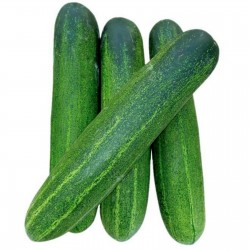Menu
-
MenuBack
- Home
-
Categories
-
-
Categories
-
Vegetable Seeds
-
Varieties by Country
- Varieties from Armenia
- Varieties from BiH
- Varieties from Croatia
- Varieties from France
- Varieties from Germany
- Varieties from Greece
- Varieties from Hungary
- Varieties from India
- Varieties from Italy
- Varieties from Japan
- Varieties from North Macedonia
- Varieties from Peru
- Varieties from Russia
- Varieties from Serbia
- Varieties from Slovenia
- Varieties from Spain
- Varieties from Thailand
- Varieties from Turkey
- Varieties from USA
- Tomato Seeds
- Corn Seeds
- Gourd family
- Bean family
- Cucumber Seeds
- Pepper Seeds
- Carrot family
- Onion family
- Lettuce Seeds
- Potato family
- Cabbage family
- Radish Seeds
- Beetroot family
- Watermelon Seeds
- Melon Seeds
- Cauliflower Seeds
- Sunflower family
-
Varieties by Country
- Fruit Seeds
- Chili - Habanero Seeds
- Medicinal Herb Seeds
- Climbing Plants Seeds
- Trees Bonsai Seeds
- Palm Seeds
- Ornamental Grasses Seeds
- Tobacco Seeds
-
Vegetable Seeds
-
-
-
-
- NEW PRODUCTS
- Create account
- Delivery - Payment
- FAQ
List of products by brand Seeds Gallery
Seeds produced by Seeds Gallery
Seeds produced by Seeds Gallery
There are 408 products.
Showing 373-384 of 408 item(s)

Variety from Serbia

This plant has giant fruits

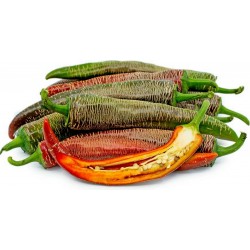
Vezanka chili - 4000 Seeds...
Price
€120.00
SKU: C 57
Seeds Gallery Com,
5/
5
<div id="idTab1" class="rte">
<h2><strong>"Vezanka" Chili 4000 Seeds Old Serbian variety</strong></h2>
<h2><span style="color: #ff0a0a;" class=""><strong>Price for Package of 4000 seeds.</strong></span></h2>
<div><span>Vezena peppers are medium to large in size and are long, slender, and taper to a point at the non-stem end, averaging one centimeter in diameter near the stem cap and 15-30 centimeters in length. The pods have prominent, horizontal tan lines, also known as corking, and these lines create a leathery texture. The skin matures from green to red and is very thin, moist, and slightly chewy. Inside the pod, there is a hollow seed cavity housing many round, pale white to cream-colored seeds that are slippery, firm, and crunchy. Vezena peppers have a mild to medium heat, are very aromatic, and are initially sweet with a nutty finish. </span>
<h2>CURRENT FACTS</h2>
<span>Vezena peppers, botanically classified as Capsicum annuum, are a rare heirloom variety native to Eastern Europe that grows on small plants reaching just under one meter in height. Also known as the Rezha Macedonian pepper, Vezeni Piperki, Vezenka, Vezanka, and Vezhenka, the name Vezena Piperka often translates to “engraved” or “embroidered,” a descriptor used to identify the pepper’s unique corked skin. Vezena peppers vary considerably in heat and average between 1,200-5,000 units on the Scoville Heat Scale, with some peppers carrying less capsaicin having a milder taste and some peppers carrying stronger heat similar to a jalapeno. Vezena peppers are commonly used as decoration and are also dried and ground for use in spices such as paprika. </span><br>
<h2>NUTRITIONAL VALUE</h2>
<span>Vezena peppers contain vitamins C, A, K, and B6, potassium, manganese, iron, magnesium, copper, and fiber. </span><br>
<h2>APPLICATIONS</h2>
<span>Vezena peppers are best suited for both raw and cooked applications such as grilling and roasting. They can be chopped, diced, and incorporated into salsas or they can be roasted or boiled and used in marmalades and spreads. Vezena peppers are also commonly dried and hung for extended use or ground into paprika and chile salt. They can also be pickled or smoked for an added flavor. Vezena peppers pair well with savory foods, omelets, onion, garlic, sour cream, yogurt, meats such as poultry, pork, beef, and fish, creamy sauces, rice, potatoes, goulash, and boiled or steamed vegetables. They will keep up to one week when stored in a paper bag in the crisper drawer of the refrigerator. Vezena peppers have extremely thin skin and will dry out quickly if left in a dry, warm environment. </span><br>
<h2>ETHNIC/CULTURAL INFO</h2>
<span>In Serbia, Vezena peppers are often hung in large clusters around homes and are dried naturally in the autumn sun. The peppers are then left as decoration or are used for grinding into spices and powders. Vezena peppers have been grown in Serbia for hundreds of years, and the Serbian farmers search for the fruits with the most corking striations and collect the seeds as these peppers are considered the most valuable to grow. </span><br>
<h2>GEOGRAPHY/HISTORY</h2>
<span>Vezena peppers are native to Eastern Europe, specifically to Serbia. The exact origins are unknown, but these peppers are believed to have been cultivated for hundreds of years and are also found in Albania, Yugoslavia, and other select areas in the Balkan region.</span></div>
</div><script src="//cdn.public.n1ed.com/G3OMDFLT/widgets.js"></script>
C 57


Variety from Serbia

This plant has giant fruits
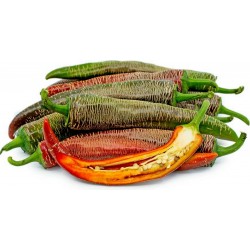
Vezanka chili - 500 Seeds...
Price
€75.00
SKU: C 57
Seeds Gallery Com,
5/
5
<h2><strong>"Vezanka" Chili 500 Seeds Old Serbian variety</strong></h2>
<h2><span style="color:#ff0000;"><strong>Price for Package of 500 seeds.</strong></span></h2>
<p><span><strong>Vezanka, Vezena </strong>peppers are medium to large in size and are long, slender, and taper to a point at the non-stem end, averaging one centimeter in diameter near the stem cap and 15-30 centimeters in length. The pods have prominent, horizontal tan lines, also known as corking, and these lines create a leathery texture. The skin matures from green to red and is very thin, moist, and slightly chewy. Inside the pod, there is a hollow seed cavity housing many round, pale white to cream-colored seeds that are slippery, firm, and crunchy. Vezena peppers have a mild to medium heat, are very aromatic, and are initially sweet with a nutty finish. </span></p>
<h2>Current Facts</h2>
<p><span>Vezena peppers, botanically classified as Capsicum annuum, are a rare heirloom variety native to Eastern Europe that grows on small plants reaching just under one meter in height. Also known as the Rezha Macedonian pepper, Vezeni Piperki, Vezenka, Vezanka, and Vezhenka, the name Vezena Piperka often translates to “engraved” or “embroidered,” a descriptor used to identify the pepper’s unique corked skin. Vezena peppers vary considerably in heat and average between 1,200-5,000 units on the Scoville Heat Scale, with some peppers carrying less capsaicin having a milder taste and some peppers carrying stronger heat similar to a jalapeno. Vezena peppers are commonly used as decoration and are also dried and ground for use in spices such as paprika. </span></p>
<h2>Nutritional Value</h2>
<p><span>Vezena peppers contain vitamins C, A, K, and B6, potassium, manganese, iron, magnesium, copper, and fiber. </span></p>
<h2>Applications</h2>
<p><span>Vezena peppers are best suited for both raw and cooked applications such as grilling and roasting. They can be chopped, diced, and incorporated into salsas or they can be roasted or boiled and used in marmalades and spreads. Vezena peppers are also commonly dried and hung for extended use or ground into paprika and chile salt. They can also be pickled or smoked for an added flavor. Vezena peppers pair well with savory foods, omelets, onion, garlic, sour cream, yogurt, meats such as poultry, pork, beef, and fish, creamy sauces, rice, potatoes, goulash, and boiled or steamed vegetables. They will keep up to one week when stored in a paper bag in the crisper drawer of the refrigerator. Vezena peppers have extremely thin skin and will dry out quickly if left in a dry, warm environment. </span></p>
<h2>Ethnic/Cultural Info</h2>
<p><span>In Serbia, Vezena peppers are often hung in large clusters around homes and are dried naturally in the autumn sun. The peppers are then left as decoration or are used for grinding into spices and powders. Vezena peppers have been grown in Serbia for hundreds of years, and the Serbian farmers search for the fruits with the most corking striations and collect the seeds as these peppers are considered the most valuable to grow. </span></p>
<h2>Geography/History</h2>
<p><span>Vezena peppers are native to Eastern Europe, specifically to Serbia. The exact origins are unknown, but these peppers are believed to have been cultivated for hundreds of years and are also found in Albania, Yugoslavia, and other select areas in the Balkan region.</span></p>
C 57


Variety from Serbia

This plant has giant fruits
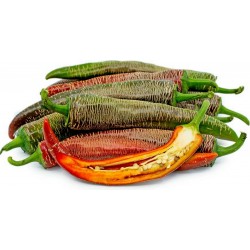
Vezanka Chili Seeds Old...
Price
€1.95
SKU: C 57
Seeds Gallery Com,
5/
5
<h2 class=""><strong>"Vezanka" Chili Seeds Old Serbian variety</strong></h2>
<h2><span style="color: #ff0000;"><strong>Price for Package of 10 or 50 seeds.</strong></span></h2>
<div><span><strong><em>Vezanka, Vezena</em> </strong>peppers are medium to large in size and are long, slender, and taper to a point at the non-stem end, averaging one centimeter in diameter near the stem cap and 15-30 centimeters in length. The pods have prominent, horizontal tan lines, also known as corking, and these lines create a leathery texture. The skin matures from green to red and is very thin, moist, and slightly chewy. Inside the pod, there is a hollow seed cavity housing many round, pale white to cream-colored seeds that are slippery, firm, and crunchy. Vezena peppers have a mild to medium heat, are very aromatic, and are initially sweet with a nutty finish. </span>
<h2>Current Facts</h2>
<span>Vezena peppers, botanically classified as Capsicum annuum, are a rare heirloom variety native to Eastern Europe that grows on small plants reaching just under one meter in height. Also known as the Rezha Macedonian pepper, Vezeni Piperki, Vezenka, Vezanka, and Vezhenka, the name Vezena Piperka often translates to “engraved” or “embroidered,” a descriptor used to identify the pepper’s unique corked skin. Vezena peppers vary considerably in heat and average between 1,200-5,000 units on the Scoville Heat Scale, with some peppers carrying less capsaicin having a milder taste and some peppers carrying stronger heat similar to jalapeno. Vezena peppers are commonly used as decoration and are also dried and ground for use in spices such as paprika. </span><br>
<h2>Nutritional Value</h2>
<span>Vezena peppers contain vitamins C, A, K, and B6, potassium, manganese, iron, magnesium, copper, and fiber. </span><br>
<h2>Applications</h2>
<span>Vezena peppers are best suited for both raw and cooked applications such as grilling and roasting. They can be chopped, diced, and incorporated into salsas or they can be roasted or boiled and used in marmalades and spreads. Vezena peppers are also commonly dried and hung for extended use or ground into paprika and chile salt. They can also be pickled or smoked for an added flavor. Vezena peppers pair well with savory foods, omelets, onion, garlic, sour cream, yogurt, meats such as poultry, pork, beef, and fish, creamy sauces, rice, potatoes, goulash, and boiled or steamed vegetables. They will keep up to one week when stored in a paper bag in the crisper drawer of the refrigerator. Vezena peppers have extremely thin skin and will dry out quickly if left in a dry, warm environment. </span><br>
<h2>Ethnic/Cultural Info</h2>
<span>In Serbia, Vezena peppers are often hung in large clusters around homes and are dried naturally in the autumn sun. The peppers are then left as decoration or are used for grinding into spices and powders. Vezena peppers have been grown in Serbia for hundreds of years, and the Serbian farmers search for the fruits with the most corking striations and collect the seeds as these peppers are considered the most valuable to grow. </span><br>
<h2>Geography/History</h2>
<span>Vezena peppers are native to Eastern Europe, specifically to Serbia. The exact origins are unknown, but these peppers are believed to have been cultivated for hundreds of years and are also found in Albania, Yugoslavia, and other select areas in the Balkan region.</span></div>
<script src="//cdn.public.n1ed.com/G3OMDFLT/widgets.js"></script>
C 57 (10 S)


Variety from Peru

This plant has giant fruits
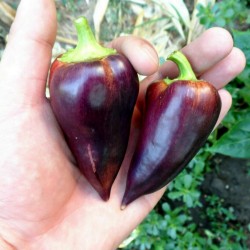
Violet Sparkle Sweet Pepper...
Price
€1.95
SKU: P 40
Seeds Gallery Com,
5/
5
<h2><strong>Violet Sparkle Sweet Pepper Seeds</strong></h2>
<h2><span style="color: #ff0000;"><strong>Price for Package of 5 seeds.</strong></span></h2>
<p>Pointed, wedge-shaped fruit is purple streaked with pale yellow. We originally received a few seeds of this variety from a Russian seed trader. Ripens red. Very lovely and delicious, sweet, crisp and thick-walled. One of the finest and prettiest peppers we have tried!</p>
<p>The flavor is excellent: sweet and aromatic, but you must wait until the peppers fully mature; they are very bland in immature stages. Wait until they are red and orange. I loved watching these peppers grow and their color change as they matured. They aren't just gorgeous in the purple stage they also turn yellow, orange, red with beautiful streaking and different color patterns when in-between colors.</p>
P 40 (5 S)

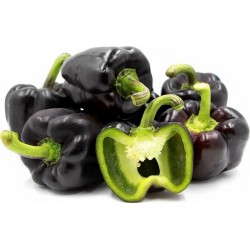
VIOLETTA Violet pepper Seeds
Price
€2.00
SKU: PP 41
Seeds Gallery Com,
5/
5
<div id="idTab1" class="rte">
<h2><strong><em><span style="text-decoration:underline;">VIOLETTA Violet pepper Seeds</span></em></strong></h2>
<h3><span style="color:#ff0000;"><strong>Price for Package of 8 seeds.</strong></span></h3>
<p>Violetta is a thick-fleshed block pepper coming in 3 different colors. These peppers weigh 250 g (0,6 lbs) each and start from violet, then turn green and then finally red. They appear riper, the sweeter. Violetta can be grown outdoors in warm areas or in greenhouses.</p>
<p>Capsicum annuum </p>
<p>Harvest: from August</p>
<p>Plant height:</p>
<p>outdoors: 70 cm (28 in)</p>
<p>indoors: more than 70 cm (28 in)</p>
</div>
PP 41 (8 S)


Variety from Russia
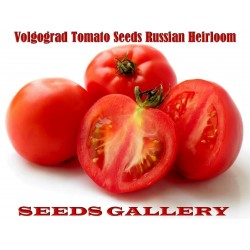
Volgograd Tomato Seeds...
Price
€2.05
SKU: VT 140
Seeds Gallery Com,
5/
5
<h2><strong>Volgograd Tomato Seeds Russian Heirloom</strong></h2>
<h2><span style="color:#f60101;"><strong>Price for Package of 10 seeds.</strong></span></h2>
<p><span>Other Names for Tomato 'Volgograd' Volgograd Winter, Volvograd. 'Volgograd' is a Tomato variety in the Solanum genus with a scientific name of Solanum lycopersicum. 'Volgograd' is considered a heirloom OP (open polliated) cultivar.</span></p>
<p><span>65 days, bush habit, regular leaf, 2-5 oz oblate or round red fruit which may have green shoulders. no cracking, the plants are loaded with fruit, very good ‘old-fashioned’ tomato taste, early tomato. good for cool season, or cool areas.</span></p>
<p><span>Dislikes heat.</span></p>
<p><span>This variety is an Fruit that typically grows as an Annual/Perennial, which is defined as a plant that can matures and completes its lifecycle over the course of one year or more.</span></p>
<p><span>Volgograd Tomato is normally fairly low maintenance and is normally quite easy to grow, as long as a level of basic care is provided throughout the year. Being aware of the basic soil, sun and water preferences will result in a happier and healthier plant.</span></p>
<p><strong><span>Growing Volgograd from seed</span></strong></p>
<p><span>Start seeds indoors six weeks before last frost date.</span></p>
<p><span>By our calculations, you should look at sowing Volgograd about 42 days before your last frost date.</span></p>
<p><strong><span>Transplanting Volgograd</span></strong></p>
<p><span>Plant to the first set of true leaves to promote strong root growth.</span></p>
<p><span>Ensure that temperatures are mild and all chance of frost has passed before planting out, as Volgograd is a tender plant.</span></p>
<p><strong><span>Tomato Volgograd Etymology</span></strong></p>
<p><span>Volgograd Winter, aka Volgograd is from the Volgograd region of Russia.</span></p>
<p><span>“Winter” sometimes tacked on to the name Volgograd, because it does best in cool weather.</span></p>
VT 140 (10 S)


Variety from America
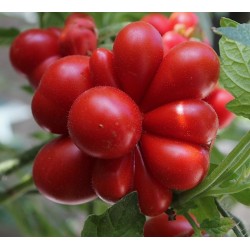
VOYAGE Tomato Seeds -...
Price
€1.95
SKU: VT 86
Seeds Gallery Com,
5/
5
<h2 class=""><strong>VOYAGE Tomato Seeds - Heirloom Variety</strong></h2>
<h2><span style="color: #ff0000;"><strong>Price for Package of 10 seeds.</strong></span></h2>
<p>Voyage Tomato is about as strange-looking tomato as you will find. The voyage tomato is an old Indian heirloom variety from Central America. It owes its name to the fact that, due to its unusual fruit form, it is ideally suited as food for travel. The name voyage comes from the idea that you can take it on a voyage and not have to eat the whole fruit. Pulling sections off and eating them as you need it.</p>
<p>Indeterminate, regular leaf, sprawling plants produce very unusually, 120 grams, red, lumpy and beautiful tomatoes.</p>
<p>Don't miss this fantastic strange variety for your garden this year...</p><script src="//cdn.public.n1ed.com/G3OMDFLT/widgets.js"></script>
VT 86

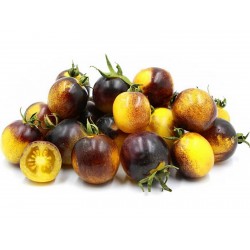
Wagner Blue Yellow Tomato...
Price
€1.65
SKU: VT 13
Seeds Gallery Com,
5/
5
<h2 class=""><strong>Wagner Blue Yellow Tomato Seeds</strong></h2>
<h2><span style="color: #ff0000;"><strong>Price for Package of 10, 20, 50 seeds.</strong></span></h2>
<p>This rare and beautiful tomato comes from the breeder Tom Wagner. Wagner Blue Yellow is a rare eye-catching tomato that is bright yellow, with dark blue marbled shoulders. They develop the blue-purple color as they grow, and the more sun that each tomato receives, the deeper that color becomes. Wagner Blue Yellow is a small salad-type tomato, though still larger than a cherry tomato at about <strong>5-6 cm in size and 50-90 grams of weight</strong>, and it has a mild, almost citrusy flavor with an appealing juicy texture. The fruits ripen after 60 to 70 days. Wagner Blue Yellow tomato plants can grow to an <strong>average of 180 cm</strong>, and they produce abundant yields of the round fruit throughout the season right up until frost.</p>
<p>Wagner Blue Yellow is not to be confused with the <a href="https://www.seeds-gallery.shop/en/home/blue-tomato-seeds-bosque-blue.html" title="Blue Tomato Seeds "Bosque Blue"" target="_blank" rel="noreferrer noopener"><strong>bosque blue tomato</strong></a>, which is a totally different variety that was released by the same farm in 2011. Wagner Blue Yellow has also been offered under the name Purple Yellow Light Bulb.</p>
<p>Wagner Blue Yellow tomatoes are great for fresh snacking, and their unique look makes them a great addition to salads. They can be used in fresh salsas...</p>
<p>Blue tomatoes like Wagner Blue Yellow are purposefully bred in the United States for the health benefits of their anthocyanin content. Until the 21st century, tomatoes grown in home gardens have had the beneficial pigment only in their leaves and stems, which are inedible, while only a few wild tomato species had anthocyanins in their fruit.</p><script src="//cdn.public.n1ed.com/G3OMDFLT/widgets.js"></script>
VT 13 (10 S)

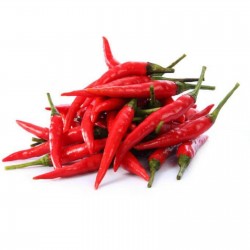
Wasp Hot Chili Seeds
Price
€2.45
SKU: C 13 (0,3g)
Seeds Gallery Com,
5/
5
<h2 class=""><strong>Wasp Hot Chili Seeds</strong></h2>
<h2><span style="color: #ff0000;"><strong>Price for Package of 100+- seeds (0,3g).</strong></span></h2>
<p>Beautiful Chili, belongs to the group chili peppers with the high ingredient of capsaicin, whereby the fruits are extraordinary hot. It forms a short stalk, numerous branches, giving the plant a bushy appearance. The fruits are 3-4 cm long, green in the technological and red in the biological maturity. By regular harvest you can get 350-400 fruits. Due to the decorative appearance and large number of fruits, this plant is suitable for growing in pots on the terraces and balconies as a decorative plant.</p><script src="//cdn.public.n1ed.com/G3OMDFLT/widgets.js"></script>
C 13 (0,3g)

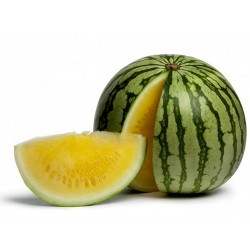
Watermelon Yellow Flesh...
Price
€1.85
SKU: V 44
Seeds Gallery Com,
5/
5
<h2>Watermelon Yellow Flesh Seeds - Super Sweet</h2>
<h2><span style="color: #ff0000;"><strong>Price for Package of <strong></strong></strong></span><span style="color: #ff0000;"><strong>5 or 10 </strong></span><span style="color: #ff0000;"><strong><strong></strong>seeds.</strong></span></h2>
<div>Watermelon Yellow Flesh is an unusual and very attractive watermelon.</div>
<div>This highly prized variety which has pure yellow flesh inside not only tastes great, it looks fabulous as well, the perfect complement to the standard red fleshed types such as Sugar Baby.</div>
<div>The flesh which is very sweet sometimes gives the impression of being bland but this is only because of the colour.</div>
<div>Watermelon Yellow Flesh produces firm, good quality and evenly shaped fruit on a bushy plant.</div>
<div>Heavy for their size the melons which can weigh anything from 3.5 - 5.5 kilos have a superb watermelon flavour and are highly rated in their native Poland.</div>
<div>Can be cultivated outdoors but gives best results in the British Isles when grown under protection.</div>
<div>
<table cellspacing="0" cellpadding="0" border="1">
<tbody>
<tr>
<td colspan="2" width="100%" valign="top">
<p><span style="color: #008000;"><strong>Sowing Instructions</strong></span></p>
</td>
</tr>
<tr>
<td valign="top" nowrap="nowrap">
<p><span style="color: #008000;"><strong>Propagation:</strong></span></p>
</td>
<td valign="top">
<p><span style="color: #008000;">Seeds</span></p>
</td>
</tr>
<tr>
<td valign="top" nowrap="nowrap">
<p><span style="color: #008000;"><strong>Pretreat:</strong></span></p>
</td>
<td valign="top">
<p><span style="color: #008000;">Damage the membranes of the seed. But not the sprouts! See Picture 3</span></p>
</td>
</tr>
<tr>
<td valign="top" nowrap="nowrap">
<p><span style="color: #008000;"><strong>Stratification:</strong></span></p>
</td>
<td valign="top">
<p><span style="color: #008000;">0</span></p>
</td>
</tr>
<tr>
<td valign="top" nowrap="nowrap">
<p><span style="color: #008000;"><strong>Sowing Time:</strong></span></p>
</td>
<td valign="top">
<p><span style="color: #008000;">all year round</span></p>
</td>
</tr>
<tr>
<td valign="top" nowrap="nowrap">
<p><span style="color: #008000;"><strong>Sowing Depth:</strong></span></p>
</td>
<td valign="top">
<p><span style="color: #008000;">0,5-1 cm</span></p>
</td>
</tr>
<tr>
<td valign="top" nowrap="nowrap">
<p><span style="color: #008000;"><strong>Sowing Mix:</strong></span></p>
</td>
<td valign="top">
<p><span style="color: #008000;">Coir or sowing mix + sand or perlite</span></p>
</td>
</tr>
<tr>
<td valign="top" nowrap="nowrap">
<p><span style="color: #008000;"><strong>Germination temperature:</strong></span></p>
</td>
<td valign="top">
<p><span style="color: #008000;">Opt. 38 ° C</span></p>
</td>
</tr>
<tr>
<td valign="top" nowrap="nowrap">
<p><span style="color: #008000;"><strong>Location:</strong></span></p>
</td>
<td valign="top">
<p><span style="color: #008000;">bright + keep constantly moist not wet</span></p>
</td>
</tr>
<tr>
<td valign="top" nowrap="nowrap">
<p><span style="color: #008000;"><strong>Germination Time:</strong></span></p>
</td>
<td valign="top">
<p><span style="color: #008000;">1-6 weeks</span></p>
</td>
</tr>
<tr>
<td valign="top" nowrap="nowrap">
<p><span style="color: #008000;"><strong>Watering:</strong></span></p>
</td>
<td valign="top">
<p><span style="color: #008000;">Water regularly during the growing season</span></p>
</td>
</tr>
<tr>
<td valign="top" nowrap="nowrap">
<p><span style="color: #008000;"><strong> </strong></span></p>
</td>
<td valign="top">
<p><br /><span style="color: #008000;"><em>Copyright © 2012 Seeds Gallery - Saatgut Galerie - Galerija semena. </em><em>All Rights Reserved.</em></span></p>
</td>
</tr>
</tbody>
</table>
</div>
V 44 (5 S)

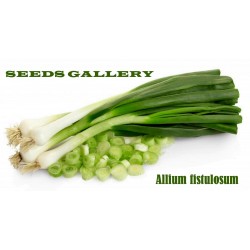
Welsh Onion Seeds (Allium...
Price
€1.55
SKU: MHS 142
Seeds Gallery Com,
5/
5
<h2><strong>Welsh Onion Seeds (Allium fistulosum)</strong></h2>
<h2><span style="color: #f80101;"><strong>Price for Package of 50 (0,13 g) seeds.</strong></span></h2>
<p><span>Long-term Welsh onion – one of ancient useful plants who can provide with valuable vitamin greens in the early spring. Its bright shoots are shown when even not all snow melted on a country site. In the people to it thought up many names: dudchaty, Chinese, sand, Tatar. Gentle, not really sharp "plumelets" are suitable for salads, garnishes, okroshka.</span></p>
<p><strong><span>Description and characteristic of Welsh onion</span></strong></p>
<p><span>Externally these onions are similar on everything the known napiform. But here the bulb underground at it is not formed. The basis of escape has only a small expansion called by botanists a false bulb. It is formed because the bases of sheet vaginas are thickened. The underground part of Welsh onion lives in the earth some years, and here the land part presented by leaves and tsvetonosa annually dies off during the autumn period. For Welsh onion strong branching, existence of a set of modified dudchaty leaves, hollow is characteristic inside. They accrue gradually, gaining the power. Depending on a grade, height of Welsh onion can be from 40 to 60 cm. For the second year of life Welsh onion throws out flower shooters, which length about 45 cm. Growing on one place, these onions well give greens for seven years. But it is best of all it does in the first four years. Then productivity considerably falls, it is connected with strong growth of underground part. Therefore in four years it should be seated in other places of a site. Surprisingly, but shoots of Welsh onion are capable to transfer spring frosts when stem of thermometer falls lower than zero by eight degrees. And here adult plants normally winter even if temperature will be-45 degrees. Therefore it is sowed often by Siberian summer residents. For normal development these onions need long light day. Optimum temperature for fast development from 18 to 22 degrees. Vitamin C in Welsh onion is approximately twice more, than in a turnip. There are in it phytoncides, essential oils, vitamins: carotene, B1, V2, PP, mineral salts of calcium, magnesium, phosphorus, iron, potassium.</span></p>
<p><span>The Chinese and Tibetan Aesculapians actively use Welsh onion as the antiseptic, all-strengthening means at treatment of gastrointestinal diseases, feverish states, skin illnesses. It is recommended to eat to hypertensive persons, it improves elastic properties of walls of capillaries.</span></p>
<p><strong><span>Site for Welsh onion</span></strong></p>
<p><span>This perennial cannot be placed on low, flooded places. A bed it is better for it to do the high. The excellent crop can be received on the structural, generously flavored with organic chemistry light loams or sandy loams. Boggy or heavy clay soil does not suit Welsh onion at all. It is also necessary to consider that on sandy and peaty soil which tend to drying, the strelkovaniye occurs much quicker. Sour soils before landing by all means should be izvestkovat or changed, adding a dolomitic flour when redigging. Well sites where grew cabbage, pumpkin, vegetable marrows, potatoes earlier are suitable for Welsh onion. If soils at you poor, on square meter it is necessary to bring about 5 kg of humus, 25 grams of ammonium nitrate, 15 grams of chloride potassium, 25 grams of superphosphate. It is better to prepare a site for Welsh onion even in the fall.</span></p>
<p><strong><span>Landing</span></strong></p>
<p><span>It is possible to sow Welsh onion from the last days of April to the last decade of July – here such long period. But that the earth was not empty if you decided to sow Welsh onion in the summer, in the spring on this place can put salad, fennel, the Beijing cabbage or a radish so far, and then after their cleaning to place Welsh onion there. At first it is desirable to wet seeds in water or solution of microfertilizers (one tablet on water liter undertakes). Only watch that seeds did not give long boring, such seeds will complicate landing process. We at first for 20 minutes presoak seeds in potassium permanganate solution (warm), and then in usual warm water which constantly we change. In advance before landing humidify the bed, and then already do grooves. On square meter about two grams of seeds leave. Depth of seal fluctuates from 1 to 2 cm (everything depends on your soil). Between plants there has to be a distance not less than 6 cm, and between ryadochka – on 18 cm. If carry out landing in the early spring (April), it is better to cover a gryadochka with a film or other ukryvny material. It will be necessary to remove it when boring seems.</span></p>
<p><strong><span>Recommendations about further leaving</span></strong></p>
<p><span>And everything is farther it will be simpler – acquaintances to us loosening, timely watering, weedings, top dressing if necessary. InfoAdvisor.net will notice that loosening it is desirable to carry out after each rain (or watering). Then the soil crust will not be formed, air will be better to get into the earth, it will more long keep moisture. When Welsh onion does not have moisture, it "becomes angry" - tastes bitter and grows coarse. If seeds from these onions are not required for you, tear off flower arrows. Now about podkormka. Do the first of them in 30 days after shoots get out, using an azofoska or a nitrofoska (on square meter take them 10 grams). Also the divorced dung water is good. That onions wintered better, in October carry out top dressing with potash fertilizers (their number of 10 grams on square meter). The next year in the spring as soon as from a gryadochka snow leaves, clean the remains of plants, cover it with ukryvny material. If build a parnichok, for example, by means of arches, receive green material for about fifteen days earlier. If to carry out having watered with warm water, it too will accelerate receiving greens.</span></p>
<p><span>If you wish to grow up Welsh onion as an odnoletnik then it is better to resort to a rassadny way of cultivation. At first sow seeds in the spring in glasses on some pieces, keep them in the greenhouse. And then already send to an open ground when at plants is on four leaves. Usually such occurs in the middle of May. Then in the middle of July you receive a good harvest of sound Welsh onion.</span></p>
<p><span>If contain Welsh onion as part of affiliated plants dig out perennial, each three or four years with the earth and replace in other place. Such way of reproduction, simple division of a big bush, is very convenient. Still such expanded bushes can be dug out with an earth lump over time and then to use for a vygonka to receive vitamin greens. It works well even on a window sill in the container.</span></p>
<p><span>Sometimes Welsh onion gets sick peronosporozy, the pale green specks blurring on a stalk and a gray-violet raid testify to it. Here it is necessary to do processing by specifics. If in plumelets you noticed a white worm, this is the wrecker called by the onions miner. Can lead its defeat to rotting of a false bulb onions flies (their larvae). Transparent, whitish stripes on a stalk of Welsh onion is a sign of that in a stalk the onions weevil was brought.</span></p>
<p><span>It is a little about harvesting. During the season it is possible to carry out some cuts (at ground level) of the accruing green material – gentle "plumelets". Manage to make the last cut to the middle of August that onions could be prepared for wintering.</span></p>
MHS 142 (50 S)


